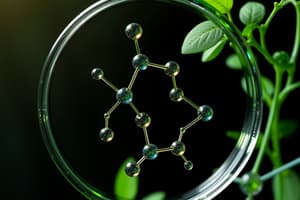Podcast
Questions and Answers
What is the principle of preventing waste in green chemistry?
What is the principle of preventing waste in green chemistry?
- Ignore waste
- Design processes to prevent waste (correct)
- Recycle waste
- Design processes to treat waste
What should be considered when designing safer chemicals and products?
What should be considered when designing safer chemicals and products?
They should be fully effective yet have little or no toxicity.
What should be the focus when designing less hazardous chemical synthesis?
What should be the focus when designing less hazardous chemical synthesis?
Use and generate substances with little or no toxicity to humans and the environment.
What is the principle behind using renewable raw materials?
What is the principle behind using renewable raw materials?
What is the advantage of using catalysts instead of stoichiometric reagents?
What is the advantage of using catalysts instead of stoichiometric reagents?
What should be avoided to minimise the potential for chemical derivatives?
What should be avoided to minimise the potential for chemical derivatives?
What is meant by maximizing atom economy?
What is meant by maximizing atom economy?
Why should safer solvents and reaction conditions be used?
Why should safer solvents and reaction conditions be used?
How can energy efficiency be increased in chemical processes?
How can energy efficiency be increased in chemical processes?
What is the purpose of designing for degradation?
What is the purpose of designing for degradation?
What is the benefit of analyzing in real time to prevent pollution?
What is the benefit of analyzing in real time to prevent pollution?
How can potential for accidents be minimized in chemistry?
How can potential for accidents be minimized in chemistry?
Flashcards
Waste Prevention
Waste Prevention
Designing processes to avoid generating waste.
Safer Chemistry
Safer Chemistry
Creating chemicals and products that are effective but have minimal toxicity.
Less Hazardous Synthesis
Less Hazardous Synthesis
Prioritizing the use of non-toxic substances in chemical reactions.
Renewable Resources
Renewable Resources
Signup and view all the flashcards
Catalysts
Catalysts
Signup and view all the flashcards
Avoid Unnecessary Derivatives
Avoid Unnecessary Derivatives
Signup and view all the flashcards
Atom Economy
Atom Economy
Signup and view all the flashcards
Safer Solvents and Conditions
Safer Solvents and Conditions
Signup and view all the flashcards
Energy Efficiency
Energy Efficiency
Signup and view all the flashcards
Design for Degradation
Design for Degradation
Signup and view all the flashcards
Real-Time Analysis
Real-Time Analysis
Signup and view all the flashcards
Minimizing Accidents
Minimizing Accidents
Signup and view all the flashcards
Study Notes
Preventing Waste
- Design chemical processes to eliminate waste, focusing on prevention rather than remediation.
Designing Safer Chemicals and Products
- Aim for chemical products that are effective yet carry minimal to no toxicity.
Less Hazardous Chemical Synthesis
- Create methods that utilize substances with low toxicity to protect humans and the environment.
Use of Renewable Raw Materials
- Source materials from renewable resources, such as plant-based materials, to support sustainability.
Catalysts Over Stoichiometric Reagents
- Implement catalysts that can facilitate multiple reactions while being used in small quantities, thus reducing waste.
Avoiding Chemical Derivatives
- Minimize the use of temporary modifications like blocking or protecting groups to reduce additional reagents and waste.
Maximizing Atom Economy
- Ensure syntheses are structured so that the final product retains the highest possible proportion of initial materials, minimizing waste "atoms."
Safer Solvents and Reaction Conditions
- Steer clear of toxic solvents for dissolving reactants or extracting products to enhance safety.
Energy Efficiency
- Reduce energy consumption by performing reactions at room temperature and pressure whenever feasible.
Designing for Degradation
- Create chemical products that can safely break down into non-toxic substances after usage to prevent environmental accumulation.
Real-Time Analysis for Pollution Prevention
- Incorporate continuous monitoring during processes to minimize or eliminate unwanted by-products.
Minimizing Potential for Accidents
- Design chemicals and their forms to reduce risks of accidents, including explosions, fires, or environmental releases.
Studying That Suits You
Use AI to generate personalized quizzes and flashcards to suit your learning preferences.




